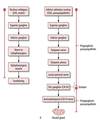CN V Flashcards
(23 cards)
Describe spiral (cochlear) ganglion
- Contains bipolar sensory neurons (1st order neurons in auditory pathway)
- Sensory ganglion
- No synapses
Define the first order neuron in the auditory pathway
- Cell bodies are located in COCHLEAR GANGLION
- Peripheral processes termiante in receptor hair cells on the organ of corti
- Central proceses (form roots of cochlear nerve) enter pons, BIFURCATE and synapse in the DORSAL COCHLEAR NUCLEUS and VENTRAL COCHLEAR NUCLEUS
- Carry info from IPSILATERAL EAR
describe the second order neuron in the auditory pathway
- Found in the dorsal and ventral cochlear nuclei
- axons ffrom the VENTRAL COCHLEAR NUCLEUS form the VENTRA ACOUSTIC STRIA (trapezoid body) which terminates in the NUCLUS OF THE TRAPEZOID BODY and the SUPERIOR OLIVARY NUCLEUS
–> others ascend the LATERAL LEMNISCUS to terminate in the nucleus of the LL and the inferior colliculus
- Axons from the DORSAL COCHLEAR NUCLEUS form the dorsal acoustic stria and ascend in the Lateral lemniscus to terminate in the inferior colliculus
** CARRY INFO FROM IPSILATERAL EAR **
describe the third order neurons in the adutiory pathway
- Relays input from BOTH EARS
- are housed in the superior olivary nuclei which are involved in the localization of sound
Define inferior colliculus
- is a relay nucleus for hearing in the midbrain
- processes input from the LATERAL LEMNISCUS
- projects to the medial geniculate nucleus (MGN)
Define Medial geniculate nucleus (MGN)
- relay nucleus for hearing in the thalamus
- processes sound intensity and frequency
- gives rise to the AUDITORY RADIATION which projects to the primary auditory cortex
define primary auditory cortex
- Brodmann’s area 41 and 42
- traverse temporal gyri of Heschl
- Role in lcoalization of sound and detection of alterations in pattern of sound
SECONDARY CORTICAL AREAS
- mutliple, difficult to lcoate
- Interpretation of sound, voices, language and music
Describe vestibular (scarpa’s) ganglion
- contains bipolar sensory neurons (1st order neurons of the vistublar pathway)
- Sensory
- No synpases
describe the first order neuron in the vestibular pathway
- cell bodies = vestibular ganglion
- Peripheral proceses = termiante in receptor hair cells of the MACULAE of the UTRICLE and SACCULE and the cristae of the semicircular canal ampullae
- Central processes = form root of vestibular nerve and enter pons, BIFURCATE and synapse in the vestibular nuclei
–> some central proceses pass into the inferior cerebellar peduncle to end in the IPSILATERAL FLOCCULONODULAR LOBE of cerebellum
describe the second order neuron in the vestibular pathway
- Housed in the vestibular nuclei
- axons join the MEDIAL LONGITUDINAL FASCICULUS (MLF) to project to the extraocular muscle nuclei, reticular formation, cervical spinal cord
- Other fibesr terminate in the cerebellum and thalamus
describe the third order neurons in the vestibular pathway
- are housed in the VPL and VPI nuclei of the thalamus
- PROJECT to the primary vestibular cotex (brodmann’s area 3a)
describe the Afferent to the vestibular nuclei
- come from:
–> vestibular nerve
- cerebellum
- CONTRALATERAL vestibular nuclei
- spinal cord
describe the functions of the CN IX
- General visceral afferent (GVA) = pharyngeal tube, palatine tonsils, pharynx, carotid sinus
- Special visceral afferent (SVA) = tase of the posterior 1/3 of tongue
- General visceral efferent (GVE) parasympathetics to the parotid gland, minor salivary glands in tongue and pharynx
- Special visceral efferents (SVE) = skeletal motor to the stylopharyngeus muscle
- General somatic afferent (GSA) = ear, ear canal, posterior 1/3 of tongue
describe the superior ganglion of the glossopharyngeal nerve
- contains PSEUDOUNIPOLAR NEURONS of general somatic afferent
- central proceses descend the spinal V tract to the spinal V nucleus
** CN IX sends it GSA fibers carrying nociception to the spinal V nucleus **
describe inferior (petrosal) ganglion of the glossopharyngeal nerve
- Pseudounipolar neurons (GVA and SVA) (general and special visceral afferents)
- central proceses join the solitary tract to termiante in the solitary nucleus

describe the otic ganglion
- Parasympathetic ganglion
- Contains postganglionic parasympathetic neurons who axons termiante in the parotid gland
- involvled in freys syndrome

Lesion in the glossopharyngeal nerve result in what?
- Loss of taste sensation
- decrease in salivary secretion
- diminished visceral sensation
- loss of gag reflex
- loss of the carotid sinus reflex
describe the functional componenets of CN X
- General visceral efferent = parasympathetic to throacic and abdominal viscera
- Special visceral efferent = skeletal motor to most pharyngeal and laryngeal skeletal muscles
- special visceral afferent = tase from epiglottis, soft palate and upper pharynx
- General somatic afferent = out ear, external auditory meatus, and posterior third of the dura matter
- General visceral afferent - mucus membranes of soft palate, pharynx, esophagus, larynx, trachea and carotid body
describe superior (jugular) ganglion of the vagus
- sensory, no synapes
- pseudounipolar neurons (GSA) –> central proceses descend in the spinal V tract to the spinal V ucleus (nociception)

describe inferior (nodose) ganglion of the vagus
- sensory, no synpases
- pseudounipolar neurons (GVA and SVA) –> central proceses join the solitary tract to terminate in the solitary nucleus

describe the Parasymapthetic ganglion of the vagus
- located near viscera or within the wall of viscera in thoracic and abdominal cavities to innervate cardiac muscle, smooth muscle and glands (heart, respiratory tract, GI tract)
what would be the result of a unilateral lesion of the vagus nerve root (as it exits the brainstem
- flaccid paralysis or weakness of muscles of the:
–> pharynx = dysphagia
–> larynx = Dysphoria
–> soft palate
- Dyspnea
- loss of gag reflex
- loss of general sensation
- cardiac arrhythmias
what would result from a bilateral lesion of the vagus nerve root
- DEATH = invompatible with life


